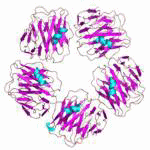Molecular Biology
|
30 november 2022 17:01:57 |
| IJMS, Vol. 23, Pages 15050: Protective Strategies of Haberlea Rhodopensis for Acquisition of Freezing Tolerance: Interaction between Dehydration and Low Temperature (International Journal of Molecular Sciences) |
|
Tweet Resurrection plants are able to deal with complete dehydration of their leaves and then recover normal metabolic activity after rehydration. Only a few resurrection species are exposed to freezing temperatures in their natural environments, making them interesting models to study the key metabolic adjustments of freezing tolerances. Here, we investigate the effect of cold and freezing temperatures on physiological and biochemical changes in the leaves of Haberlea rhodopensis under natural and controlled environmental conditions. Our data shows that leaf water content affects its thermodynamical properties during vitrification under low temperatures. The changes in membrane lipid composition, accumulation of sugars, and synthesis of stress-induced proteins were significantly activated during the adaptation of H. rhodopensis to both cold and freezing temperatures. In particular, the freezing tolerance of H. rhodopensis relies on a sucrose/hexoses ratio in favor of hexoses during cold acclimation, while there is a shift in favor of sucrose upon exposure to freezing temperatures, especially evident when leaf desiccation is relevant. This pattern was paralleled by an elevated ratio of unsaturated/saturated fatty acids and significant quantitative and compositional changes in stress-induced proteins, namely dehydrins and early light-induced proteins (ELIPs). Taken together, our data indicate that common responses of H. rhodopensis plants to low temperature and desiccation involve the accumulation of sugars and upregulation of dehydrins/ELIP protein expression. Further studies on the molecular mechanisms underlying freezing tolerance (genes and genetic regulatory mechanisms) may help breeders to improve the resistance of crop plants. |
| 91 viewsCategory: Biochemistry, Biophysics, Molecular Biology |
 IJMS, Vol. 23, Pages 15047: Effects of Fhb1, Fhb2 and Fhb5 on Fusarium Head Blight Resistance and the Development of Promising Lines in Winter Wheat (International Journal of Molecular Sciences) IJMS, Vol. 23, Pages 15047: Effects of Fhb1, Fhb2 and Fhb5 on Fusarium Head Blight Resistance and the Development of Promising Lines in Winter Wheat (International Journal of Molecular Sciences)IJMS, Vol. 23, Pages 15052: Opposite Regulation of Homer Signal at the NMJ Postsynaptic Micro Domain between Slow- and Fast-Twitch Muscles in an Experimentally Induced Autoimmune Myasthenia Gravis (EAMG) Mouse Model (International Journal of Molecular Sciences) 
|
| blog comments powered by Disqus |
MyJournals.org
The latest issues of all your favorite science journals on one page
The latest issues of all your favorite science journals on one page



